Summer Oyster Mushroom
£18.00
The Summer Oyster Mushroom is a beautiful, versatile, and tasty mushroom that thrives in warm weather.
Out of stock
- Satisfaction Guaranteed
- No Hassle Refunds
- Secure Payments
Summary
The Summer Oyster mushroom, scientifically known as Pleurotus pulmonarius, is a species within the Pleurotus genus, which also includes other well-known varieties like the common Oyster mushroom (Pleurotus ostreatus). However, what distinguishes The Summer Oyster mushroom from other oyster mushrooms is its adaptability to warmer temperatures and its ability to grow during the summer months, unlike other Oyster species that thrive in cooler conditions. Tasty and versatile, the Summer Oyster mushroom is a chef’s favourite during the summer.
The Summer Oyster Mushroom Description and Taste
The cap of the Summer Oyster mushroom typically ranges from 5 to 15 cm in diameter. Its shape starts as convex and gradually flattens as it matures. Depending on environmental conditions and substrate, the cap can vary from pale white to a light brownish hue.
The gills are white to cream-coloured, densely packed, and descending slightly down the stem. The stem is often short and off-centre or absent, which is characteristic of many Oyster mushrooms, such as the Black Pearl King Oyster. It is usually white or light-colored and can be slightly fuzzy or smooth.
What are the Uses of the Summer Oyster Mushroom?
The Summer Oyster mushroom (Pleurotus pulmonarius) is highly versatile and can be used in various ways across culinary, medicinal, and environmental applications. Here’s a breakdown of its uses:
Culinary uses of The Summer Oyster Mushroom
- Cooking: The Summer Oyster mushroom is widely used in cooking due to its mild, slightly sweet flavour and tender texture. It can be sautéed, stir-fried, grilled, or roasted, and it pairs well with a variety of ingredients like garlic, onions, butter, and herbs. Common dishes include:
- Stir-Fries: Added to vegetable stir-fries for a soft texture and to absorb the flavors of sauces.
- Soups and Stews: Used in broths and stews for added depth and a subtle umami flavour.
- Pasta and Risotto: Mixed into pasta dishes or risottos to provide an earthy note and enhance the dish’s overall richness.
- Toppings: Used as a topping for pizzas or salads to add a delicate mushroom flavour.
- Preservation: They can also be dried and rehydrated later, which intensifies their flavour, or they can be pickled for long-term storage and use.
Medicinal Uses of the Summer Oyster Mushroom
- Immune Support: Like other mushrooms in the Pleurotus genus, Summer Oysters contain beta-glucans and other polysaccharides, which are known for their immune-boosting properties. These compounds may help modulate the immune system and support overall health.
- Antioxidant Properties: Summer Oysters’ antioxidants help combat oxidative stress, which is linked to various chronic diseases. Regular consumption may reduce the risk of conditions related to oxidative damage.
- Cholesterol-Lowering: Some studies suggest that Pleurotus mushrooms may help lower cholesterol levels, supporting cardiovascular health.
Environmental Uses of the Summer Oyster Mushroom
- Mycoremediation: Summer Oyster mushrooms can be used in mycoremediation, a process in which fungi breaks down and detoxifies pollutants in the environment. They are particularly effective in breaking down complex organic compounds like hydrocarbons found in oil spills.
- Waste Recycling: These mushrooms can grow on a variety of agricultural waste products, turning what would otherwise be waste into valuable food. This process is not only environmentally friendly but also economically beneficial.
Nutritional Value From the Summer Oyster Mushroom Grow Kits
Summer Oysters are low in calories but rich in protein, fibre, vitamins (especially B vitamins), and minerals like potassium, iron, and zinc. They are also a good source of antioxidants, which contribute to overall good health. The subject of key studies, the Summer Oyster is packed full of nutrition.
Here’s a breakdown of its nutritional value per 100 grams of raw Summer Oyster mushroom:
Nutritional Value of Summer Oyster Mushroom (Per 100 grams)
- Calories: Approximately 33-42 kcal
- Protein: 3.3 – 4.5 grams
- Fat: 0.3 – 0.4 grams
- Carbohydrates: 6.0 – 7.0 grams
- Dietary Fibre: 2.3 – 3.2 grams
- Sugars: 1.1 – 1.7 grams
- Vitamins:
- Vitamin D: 28-40 IU (due to their exposure to sunlight or UV light)
- B Vitamins: Including Niacin (B3) – 5.5 mg, Riboflavin (B2) – 0.3 mg, and Pantothenic Acid (B5) – 1.3 mg.
- Folate: 30-35 mcg
- Minerals:
- Potassium: 420-450 mg
- Phosphorus: 120-140 mg
- Iron: 0.8 – 1.3 mg
- Magnesium: 18-20 mg
- Zinc: 0.6 – 1.1 mg
- Copper: 0.25 – 0.3 mg
- Selenium: 2.6 – 3.0 mcg
- Antioxidants: Rich in antioxidants like ergothioneine and glutathione, which help combat oxidative stress and reduce the risk of chronic diseases.
Health Benefits Related to Nutritional Content
- Low in Calories: The low-calorie content makes it a great addition to weight management diets.
- High Protein Content: Provides a good source of plant-based protein, suitable for vegetarians and vegans.
- Rich in Fibre: Contributes to digestive health by promoting regular bowel movements and supporting a healthy gut microbiome.
- Vitamins and Minerals: The B vitamins support energy metabolism and brain health, while minerals like potassium and magnesium are essential for cardiovascular health and muscle function.
- Antioxidants: The presence of antioxidants contributes to reducing oxidative stress, potentially lowering the risk of inflammation-related diseases.
These nutritional values make the Summer Oyster mushroom a healthy and versatile ingredient, contributing to a balanced diet.
How to Store Summer Oyster Mushrooms?
Storing Summer Oyster mushrooms properly is essential to maintaining their freshness, flavor, and texture. The fresher you eat them, the tastier they are. However, the Summer oysters can be stored and have their freshness maintained for longer than most Oyster mushrooms. Here are some best practices for storing these mushrooms:
Refrigeration of summer oysters
- Temperature: Store Summer Oyster mushrooms in the refrigerator at 1°C to 4°C (34°F to 39°F).
- Packaging:
- Paper Bags: The best way to store them is in a paper bag, which allows the mushrooms to breathe while preventing moisture buildup that can lead to spoilage. Avoid using plastic bags, as they trap moisture and can cause the mushrooms to become slimy.
- Loose in the Crisper: If you don’t have a paper bag, you can also store them loosely in the crisper drawer of your refrigerator. Cover them lightly with a paper towel to absorb excess moisture.
- Shelf Life: When stored properly, Summer Oyster mushrooms can last up to 5-7 days in the refrigerator.
Freezing summer oysters
- Blanching First: If you want to store them for a more extended period, you can freeze Summer Oyster mushrooms, but it’s best to blanch them first to preserve their texture and flavor.
- Blanching Process: Boil the mushrooms for about 1-2 minutes, then immediately transfer them to an ice bath to stop the cooking process.
- Freezing Directly: After blanching, pat them dry, place them on a baking sheet to freeze individually, and then transfer them to an airtight container or freezer bag.
- Shelf Life: Frozen mushrooms can last up to 6 months, though they may lose some texture and become slightly rubbery when thawed.
Drying Summer oysters
- Air Drying: You can air dry the mushrooms by spreading them out in a well-ventilated area or using a dehydrator. This method is suitable for long-term storage.
- Storage: Once fully dried, store the mushrooms in an airtight container in a cool, dark place. Dried mushrooms can be rehydrated before use and will keep for up to a year.
Pickling summer oyster mushrooms
- Pickling: Pickling is another option for preserving Summer Oyster mushrooms. They can be pickled in a vinegar brine, which adds a tangy flavor and extends their shelf life.
- Shelf Life: Pickled mushrooms can be stored in the refrigerator for several months.
Summer Oysters Out in the Wild
The Summer Oyster mushroom is primarily found in temperate and subtropical regions worldwide. It is widely distributed in North America, Europe, Asia, and parts of Africa.
The Summer Oyster mushroom commonly grows on dead or dying deciduous hardwood trees, particularly species like beech, oak, and elm. It can also be found on maple, poplar, and other broadleaf trees. It thrives on decaying wood, stumps, and fallen logs, where it helps decompose the wood, returning nutrients to the ecosystem. In some cases, this mushroom can also colonize agricultural waste, like straw or sawdust, when these materials are left in humid environments.
Growing Tips
Use a sharp and clean knife, and make 2 incisions corner to corner of the window in the bag (making an X shape), exposing the substrate block. Water with a few squirts from a spray bottle. Place upright in a light, well-ventilated area with the opening facing daylight but not in direct sunlight. Your mushrooms will grow best at temperatures between 18ºC-22ºC.
Harvest the mushrooms when they are no longer doubling in size. To pick, reach underneath, grabbing the mushrooms at the base of the stem and twist firmly to release.
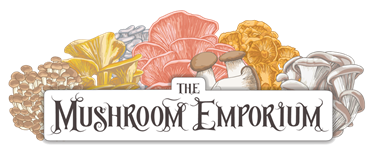
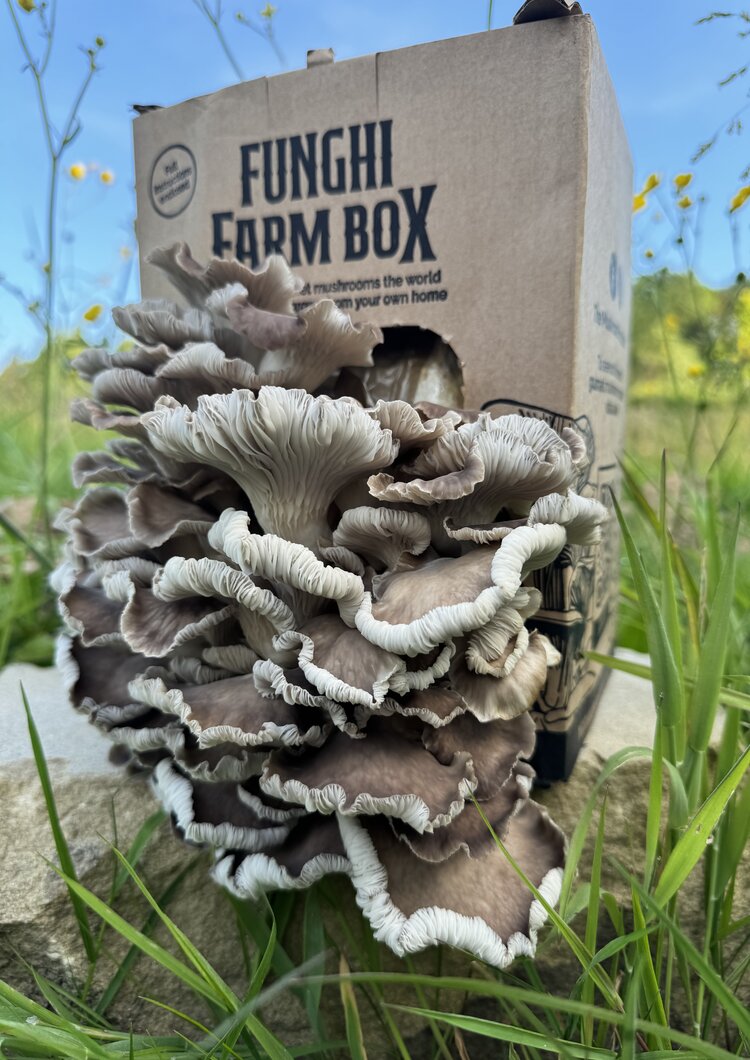
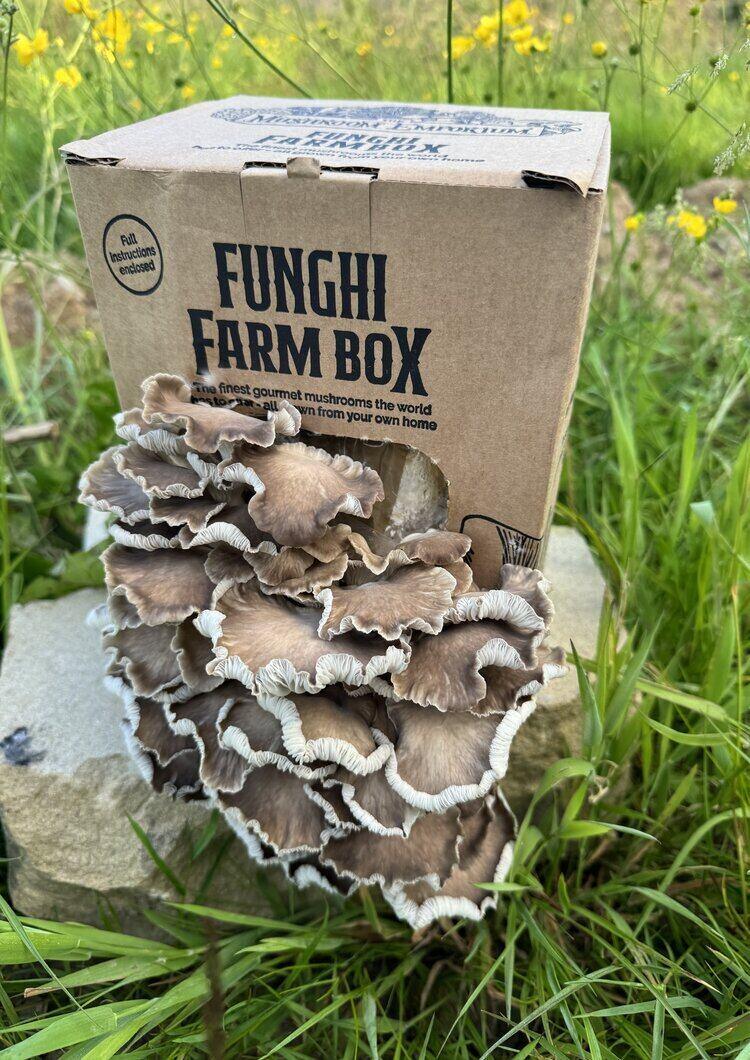
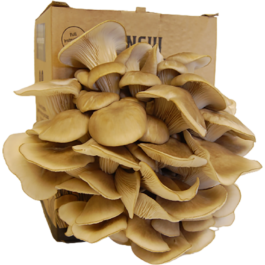
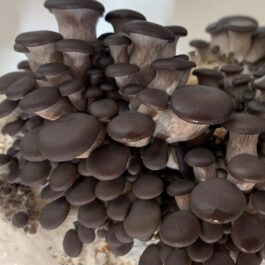
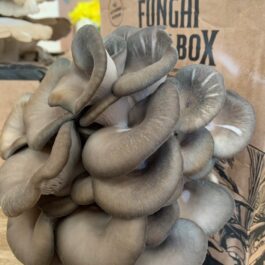

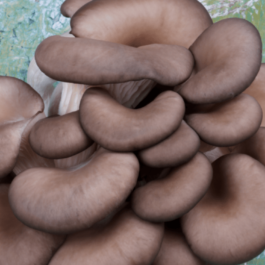
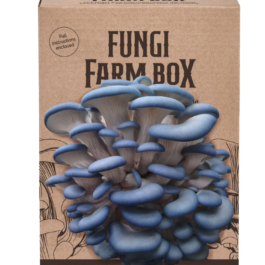
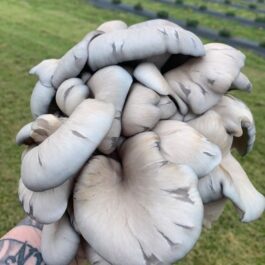
Reviews
There are no reviews yet.